谈翻译应符合外语的表达习惯
交际翻译理论的三大原则

交际翻译理论的三大原则
交际中文翻译理论的三大原则是:
1.传达准确原则:翻译应准确传达源语言的意思,保持足够的准确度,使读者能够理解原文的信息和内涵。
翻译者需要深入理解源语言的语境、
文化背景和意义,以确保目标语言的传达和表达准确无误。
2.流畅可读原则:翻译应该具备良好的语言表达能力,以确保译文在
目标语言中流畅自然,符合目标语言的语言习惯和表达习惯。
翻译者需要
以读者的角度考虑,选择合适的词汇、语法结构和表达方式,以便读者能
够轻松理解并接受译文。
3.忠实可信原则:翻译应忠实地表达源语言的原意和风格,尽力保持
原文的风味和特色。
翻译者在表达方式上应遵循源语言的风格特点,并尽
可能保留原文的语言风格和文化特色,以确保目标语言的译文与原文一致
且可信。
同时,翻译者也需要遵守文化差异和习语的规则,以确保译文能
在目标语言文化背景下有效传达信息。
翻译的标准

翻译的标准
翻译的标准是指根据原文的语义、风格和表达方式,将其准确、清晰地转化为目标语言,使读者能够完全理解原文的内容。
翻译的标准应符合以下几个要求:
1. 准确性:翻译要求准确地表达原文的意思,不得随意添加、删除或修改原文的信息。
必须理解原文中的词汇、短语和句子结构,并将其翻译为与之相对应的目标语言词汇、短语和句子结构。
2. 清晰度:翻译要求使用目标语言的正确语法、词汇和表达方式,以便读者能够轻松阅读和理解翻译的内容。
翻译应避免使用模糊、含糊不清或不准确的表达方式,而应使用简洁明了的语言进行翻译。
3. 自然度:翻译要求表达得自然流畅,与目标语言的表达习惯和习语一致。
翻译应避免使用生硬、直译的方式,而应根据上下文和语境适当调整翻译,使之与目标语言的表达方式相符。
4. 一致性:翻译要求在整篇翻译中保持一致的语言风格和术语。
翻译应遵循统一的翻译规范和术语表,确保不同部分之间的翻译一致性,避免使用不同的术语或表达方式。
5. 文化适应性:翻译要求具备一定的文化适应能力,根据目标语言国家或地区的文化背景和使用习惯,进行相应的翻译调整。
翻译应避免使用与目标文化背景相悖的表达方式或内容。
总之,翻译的标准是准确、清晰、自然、一致和具有文
化适应性的。
翻译人员应根据以上要求进行翻译,以确保目标语言读者能够准确理解并流畅阅读翻译的内容。
翻译质量控制

翻译质量控制翻译质量控制是确保翻译工作达到高质量标准的关键步骤。
在进行翻译工作时,质量控制是必不可少的,它能够确保翻译结果准确、流畅、符合语言习惯,并满足客户的需求。
本文将详细介绍翻译质量控制的步骤和标准。
1. 术语一致性:在进行翻译工作时,术语的一致性非常重要。
翻译人员应该根据客户提供的术语表,确保在整个翻译过程中使用统一的术语。
这样可以避免术语混乱或者错误,提高翻译质量。
2. 语法和语言习惯:翻译人员应该熟悉目标语言的语法和语言习惯,以确保翻译结果符合目标语言的表达习惯。
在翻译过程中,应注意句子结构、时态、语气等方面的准确性,避免浮现语法错误或者不自然的表达。
3. 文化适应性:翻译人员应该了解源语言和目标语言之间的文化差异,并在翻译过程中进行适当的调整。
这包括对习惯用语、俚语、文化隐喻等的理解和运用。
通过适当的文化适应,可以确保翻译结果更加贴近目标语言读者的文化背景,提高翻译质量。
4. 校对和审校:在翻译完成后,应进行校对和审校工作。
校对人员应该对翻译结果进行子细检查,确保译文的准确性和流畅性。
审校人员则应对翻译结果进行更深入的审查,包括对术语、语法、语言习惯等方面的检查。
校对和审校是确保翻译质量的重要环节,可以发现并纠正翻译过程中可能存在的错误或者不许确之处。
5. 反馈和改进:翻译质量控制的最后一步是采集反馈并进行改进。
客户的反馈是非常珍贵的,可以匡助我们了解翻译质量的问题和改进的方向。
根据客户的反馈,我们可以对翻译人员进行培训和指导,提高他们的翻译能力和质量意识。
同时,我们也应建立一个反馈机制,及时采集和处理客户的意见和建议,以不断改进翻译质量。
总结起来,翻译质量控制需要从术语一致性、语法和语言习惯、文化适应性、校对和审校以及反馈和改进等方面进行全面考虑。
通过严格控制每一个环节,我们可以提高翻译质量,满足客户的需求,并建立良好的信誉和口碑。
汉英翻译应符合英语表达习惯解读

汉英翻译应符合英语表达习惯摘要:汉英翻译并非词与词、句与句的简单对等,而是反映学生理解和接受意义的思维过程。
汉英语族的思维习惯不同,因此表达习惯也不同。
有些句子翻译成英语后可能完全符合语法形式,但若仔细体会,却可反映汉英思维方式和表达习惯的不同。
关键词:汉英翻译表达习惯在2001 年全国暑期英汉翻译高级研讨讲习班上,清华大学的王宁教授认为:“翻译现在正经历一种转折:从属于语言学层面的字面移译逐步转向文化层面的阐释和再现。
”英汉翻译如此,汉英翻译也是一样。
它并非词与词、句与句的简单对等,而是反映学生理解和接受意义的思维过程。
一个种族的表达习惯是长期思维习惯的结果。
汉英语族的思维习惯不同,因此表达习惯也不同,这是造成中国式英语的重要原因。
在翻译过程中不能只拘泥于句子的语法形式而忽略表达习惯。
因为有些句子翻译成英语后可能完全符合语法形式,但若仔细体会,却可反映汉英思维方式和表达习惯的不同。
一、汉语先叙述某件事情,再表达自己的感觉。
而英语通常先说出感觉再叙事。
1、答不出这个问题,我觉得很难堪。
汉语表达习惯(以下简称汉) :Because I couldn’tanswer this question , I felt ashamed.英语表达习惯(以下简称英) : I felt ashamed of notbeing able to answer the question.2、玛俐没有被邀请,所以很失望。
汉:Because she was not invited ,Mary was disappointed.英:Mary was disappointed that she was not in vited.3、他这样对待我,我很生气。
汉:The way he treated me made me angry.英: I was angry at the way he treated me.二、和对于英语语族的人来说,汉语族人喜欢用动词表达自己,而英语族人注重抽象思维,常化动为静。
(论文)论翻译的原则-外语翻译1_070425121009

(论文)论翻译的原则-外语翻译摘要:抽象的标准如“善译”和“化境”是不可实现的理想,与其取法不可实现的理想,毋宁提出切实具体的要求作为翻译的基本原则:1)信守原文的内容意旨;2)遵从译语的语言习惯;3)切合原文的语体语域。
关键词:信守内容意旨;遵从译语习惯;切合语体语域Abstract: Transmigration, an abstract whole at large, is too good to be practical and such concrete subwholes und er “good translation” as fidelity to the source-language text in content and intention, grammatical normality, and lexical appropriateness are more workable as cardinal principles of translation.Key words: fidelity; grammatical normality; lexical appropriateness翻译是把一种语言文字所表达的意义用另一种语言文字表达出来,具体说来,就是“换易言语使相解也”。
①但是,如何用另一种语言文字把一种语言文字所表达的意义表达出来?“换易言语”之后是否能“相解”?“相解”的程度如何?这些问题归结起来无疑就是:翻译的标准是什么?翻译的方法应如何?严复是中国近代第一位系统介绍西方学术的启蒙思想家,在介绍西学的同时提出了翻译的标准—“信、达、雅”,对中国现代的翻译实践和理论研究影响巨大,“相信只要中国还有翻译,总还会有人念…三字经‟!”②虽然严复持论有故,但认真审视不难发现,“信、达、雅”实质上既不是具有高度概括力的抽象标准,也不是具有切实指导性的具体标准,“从纯理论的角度讲,把信、达、雅并列起来作为翻译标准是具有逻辑缺陷的,因为这似乎意味着:原文不达,也可以故意使之…达‟;原文不雅,也可以故意使之…雅‟。
中英文翻译中的口语表达习惯和技巧
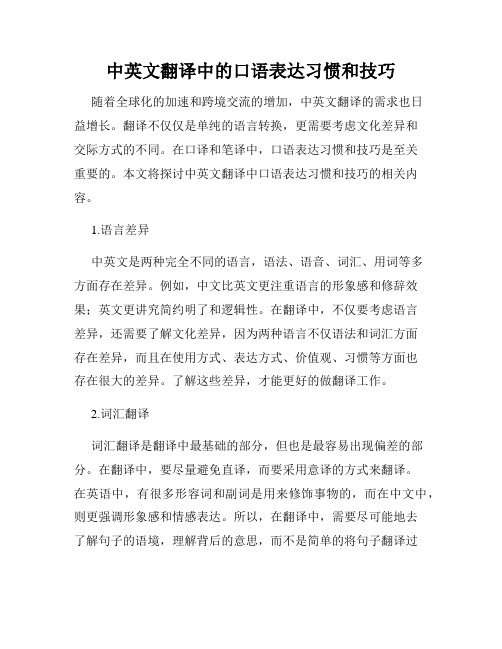
中英文翻译中的口语表达习惯和技巧随着全球化的加速和跨境交流的增加,中英文翻译的需求也日益增长。
翻译不仅仅是单纯的语言转换,更需要考虑文化差异和交际方式的不同。
在口译和笔译中,口语表达习惯和技巧是至关重要的。
本文将探讨中英文翻译中口语表达习惯和技巧的相关内容。
1.语言差异中英文是两种完全不同的语言,语法、语音、词汇、用词等多方面存在差异。
例如,中文比英文更注重语言的形象感和修辞效果;英文更讲究简约明了和逻辑性。
在翻译中,不仅要考虑语言差异,还需要了解文化差异,因为两种语言不仅语法和词汇方面存在差异,而且在使用方式、表达方式、价值观、习惯等方面也存在很大的差异。
了解这些差异,才能更好的做翻译工作。
2.词汇翻译词汇翻译是翻译中最基础的部分,但也是最容易出现偏差的部分。
在翻译中,要尽量避免直译,而要采用意译的方式来翻译。
在英语中,有很多形容词和副词是用来修饰事物的,而在中文中,则更强调形象感和情感表达。
所以,在翻译中,需要尽可能地去了解句子的语境,理解背后的意思,而不是简单的将句子翻译过去。
在处理词汇时,还需要特别关注一些熟悉度不高的词汇,并注意一些词汇的多义性和语义拓展。
3.语法翻译语法翻译是翻译中最重要的环节之一。
虽然中英语法存在较大差异,但在语法上也存在很多相似之处。
这就需要翻译者掌握语法的基础知识,将基础知识应用到语法翻译中,以确保译文的准确度。
4.口语表达习惯和技巧在口译和笔译中,口语表达习惯和技巧是至关重要的,但是口语表达习惯和技巧也是最难掌握的。
为了更好地掌握口语表达,本文将从语音、语调和语气三个方面讲述口语表达习惯和技巧。
语音:语音是口语表达习惯和技巧的最基础部分。
正确发音是口语表达的前提。
在口译中,翻译者必须具备准确、清晰、自然的语音,这样才能使听者更好地理解翻译内容。
为了提高语音表达能力,翻译人员可以多读、多听标准发音,如BBC或CNN等资讯源。
语调:语调是指语音的升降调,是表达情感、语气的重要表现形式。
四级考纲中翻译的要求
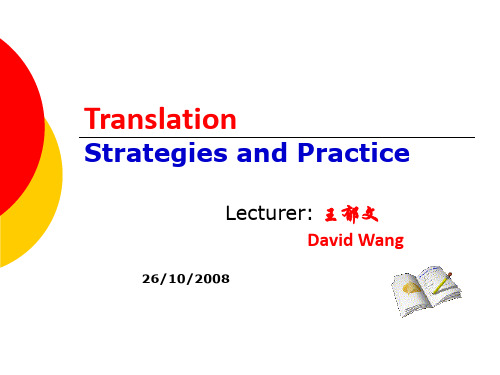
90. _______(很多人所没有意识到的) is that Simon is a lover of sports, and football in particular. What many people haven’t realized 91. The study shows that the poor functioning of the human body is ____________ (与缺乏锻炼密切相关). closely related to the lack of exercises.
90. Through the project, many people have received training and _______(决定自己创业). decided to start their own business 91. The anti-virus agent was not known ____________ (直到一名医生偶然发现了它). until a doctor found it by accident (accidentally)
CET 2008.6翻译 翻译 87. Our efforts will pay off if the result of this research _______(能应用于新技术的开发). can be applied to the exploration of new technology. 88. I can’t boot my computer now. Something _____________(一定出了毛病) with its operating system. must be wrong 89. Leaving one’s job, _______________ (不管是什么工 作), is a difficult change, even for those who look forward to retiring. no matter what kind (of job it is)
翻译技巧和策略的总结

句子流畅性
03
译文应通顺流畅,符合目标语言的表达习惯,无生硬、冗余的
表述。
文化质量的评估
文化对等性
评估译文是否保留了原文的文化内涵,是否在目标语言中找到了 恰当的文化对应表达。
文化背景解释
对于原文中具有特定文化背景的表述,译文应进行必要的解释和说 明。
文化意象的处理
在翻译过程中,应妥善处理文化意象的转换,避免造成文化误解。
语义翻译与交际翻译
语义翻译
注重原文的语法结构和词汇意义,力求在目标语言中找到最贴切的表达方式。
交际翻译
强调译文的交际效果,关注目标读者对译文的反应和接受程度。
整体翻译与部分翻译
整体翻译
将原文作为一个整体进行翻译,注重整体意义的传递和表达。
部分翻译
将原文按照不同的部分进行翻译,注重各个部分之间的逻辑关系和衔接。
参考在线词典
利用在线词典查找单词、短语、句子的准确含义和用法。
获取专业领域知识
通过在线学习平台、论坛等获取专业领域பைடு நூலகம்知识和术语,提高翻 译的专业性。
06
翻译质量的评估
语言质量的评估
语法正确性
01
评估译文是否符合目标语言的语法规则,表达清晰,无歧义。
词汇准确性
02
确保译文选词恰当,与原文意义一致,无错译、乱译现象。
文化意象的处理
对于具有特定文化背景的词汇或 表达,应谨慎处理,避免误译。
文化信息的传递
尽可能传递原文中的文化信息, 保持译文的完整性和丰富性。
02
常见的翻译技巧
直译与意译
直译
按照原文的词序和结构进行翻译 ,尽量保留原文的形式和意义。
意译
不拘泥于原文的形式,以传达原 文的深层含义为主,重组句子结 构和词汇顺序。
泰特勒的三个翻译原则
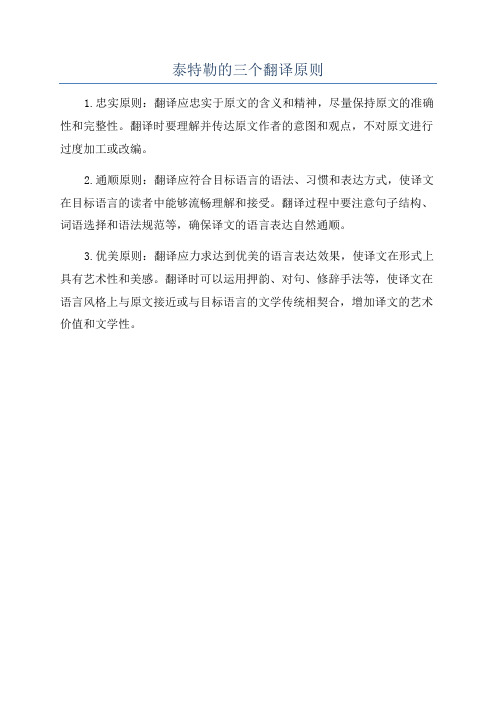
泰特勒的三个翻译原则
1.忠实原则:翻译应忠实于原文的含义和精神,尽量保持原文的准确性和完整性。
翻译时要理解并传达原文作者的意图和观点,不对原文进行过度加工或改编。
2.通顺原则:翻译应符合目标语言的语法、习惯和表达方式,使译文在目标语言的读者中能够流畅理解和接受。
翻译过程中要注意句子结构、词语选择和语法规范等,确保译文的语言表达自然通顺。
3.优美原则:翻译应力求达到优美的语言表达效果,使译文在形式上具有艺术性和美感。
翻译时可以运用押韵、对句、修辞手法等,使译文在语言风格上与原文接近或与目标语言的文学传统相契合,增加译文的艺术价值和文学性。
英语专八翻译试题及答案
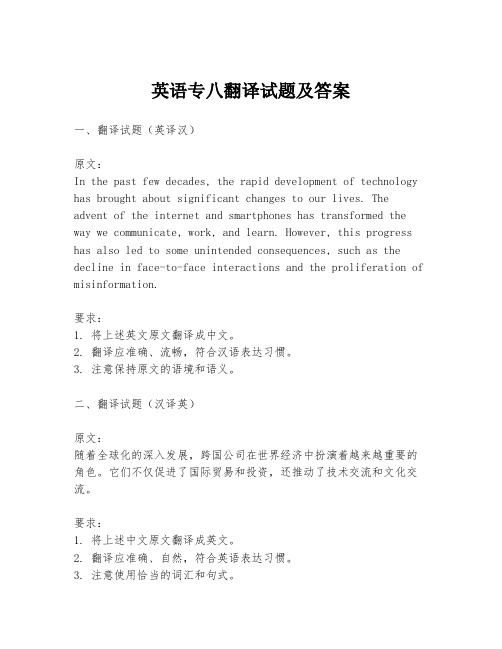
英语专八翻译试题及答案一、翻译试题(英译汉)原文:In the past few decades, the rapid development of technology has brought about significant changes to our lives. The advent of the internet and smartphones has transformed the way we communicate, work, and learn. However, this progress has also led to some unintended consequences, such as the decline in face-to-face interactions and the proliferation of misinformation.要求:1. 将上述英文原文翻译成中文。
2. 翻译应准确、流畅,符合汉语表达习惯。
3. 注意保持原文的语境和语义。
二、翻译试题(汉译英)原文:随着全球化的深入发展,跨国公司在世界经济中扮演着越来越重要的角色。
它们不仅促进了国际贸易和投资,还推动了技术交流和文化交流。
要求:1. 将上述中文原文翻译成英文。
2. 翻译应准确、自然,符合英语表达习惯。
3. 注意使用恰当的词汇和句式。
三、参考答案(一)英译汉参考答案:在过去的几十年里,科技的快速发展给我们的生活带来了显著的变化。
互联网和智能手机的出现改变了我们的交流、工作和学习方式。
然而,这种进步也导致了一些意料之外的后果,比如面对面交流的减少和错误信息的泛滥。
(二)汉译英参考答案:With the deepening development of globalization,multinational companies are playing an increasingly important role in the world economy. They not only promoteinternational trade and investment but also drive the exchange of technology and culture.四、评分标准1. 翻译准确性:译文应忠实原文,不得有遗漏或添加。
英语翻译的十大技巧

英语翻译的十大技巧翻译作为一项重要的语言交际方式,对于各行各业的人们来说都非常重要。
而作为全球通用的语言,英语翻译更是受到许多人的关注。
所以,在学习英语翻译技巧方面,可谓是不可或缺的过程。
本文将介绍十大英语翻译技巧,希望能够给大家带来实用的帮助和启示。
一、熟悉语言表达方式在进行翻译之前,首先需要了解英语语言的表达方式。
这样可以更好的了解英语的文化背景,使翻译得以正确传递,更能符合读者的意图。
二、积累词汇库词汇是语言的基础,因此建立一个丰富的词汇库对于翻译非常重要。
同时,使用英语词典也是必不可少的工具。
在翻译的过程中,需要时刻调整自己的词汇库,增强语言的多元性和语境的适应性。
三、了解语法和句子结构英语句子结构和中文有很大不同,因此掌握英语的语法和句子结构可以有效的提高翻译的质量。
学习语法可以提升自己对英语语言的理解,更能使翻译更加准确和规范。
四、注重语言习惯语言习惯的不同也有可能造成翻译的困难。
因此,注重语言习惯的差异是非常必要的。
例如,在英语中“it”这个单词有着多种用途,而在中文中则没有这么灵活。
因此,在进行翻译的时候,要考虑到不同语言习惯的差异性,遵循对方语言的表达方式。
五、语境意义的理解语境对于翻译非常重要。
因此,在进行翻译的时候,我们不仅需要理解翻译对象的表达方式,还需要理解其中隐含的意义。
只有这样才能做到准确的翻译,更好地传达原意。
六、文化差异的识别随着全球化的趋势,文化差异同样成为翻译中需要注意的问题。
由于英美文化和中国文化存在着巨大的差异,翻译过程中需要深入理解两种文化的差异,才能更好地判断阐述的内容是否合理和准确完整。
七、寻找适当的同义词在翻译的过程中,必须注意到英语和中文之间经常存在着词义的不同。
因此,在有需要时要寻找合适的同义词,这样就可以确保翻译对象的意思更精确无误。
八、避免直译直译往往会出现语义的不统一和错误,进而导致意思被人误解。
因此,在进行翻译的时候,应该尽可能避免直译,并使用更富有表达力的方式来传达信息。
英语翻译标准

英语翻译标准英语翻译标准是指在翻译过程中需要遵循的一系列规范和要求,以确保译文准确、流畅、符合语言习惯并能够传达原文的意思。
在进行英语翻译时,我们需要遵循一定的标准,以保证翻译质量和准确性。
下面将从准确性、流畅性和符合语言习惯性三个方面来探讨英语翻译的标准。
首先,准确性是英语翻译的重要标准之一。
在进行翻译时,译者需要准确理解原文的意思,并将其准确地表达出来。
这包括对原文语义、语法结构和语言风格的准确把握,以及对专业术语和行业背景的准确理解。
译文的准确性直接影响着翻译质量,因此译者在翻译过程中需要对原文进行深入的分析和理解,确保译文能够忠实地传达原文的意思。
其次,流畅性也是英语翻译的重要标准之一。
译文的流畅性指的是译文在语言表达上的通顺和自然度。
译者需要注意句子的连接和过渡,避免译文中出现生硬、拗口或不通顺的表达。
同时,译文的语言风格也需要与原文相符合,保持一致的语言特点和风格特色。
流畅的译文能够增强读者的阅读体验,使其更容易理解和接受译文内容。
最后,符合语言习惯性也是英语翻译的重要标准之一。
不同语言有着不同的表达习惯和语言特点,译者需要在翻译过程中充分考虑目标语言的语言习惯,避免直译和生搬硬套。
译文需要符合目标语言的表达习惯和语言习惯,使译文更具地道性和可读性。
同时,译者还需要注意文化差异对翻译的影响,避免出现与目标读者文化背景不符合的表达,确保译文能够被目标读者理解和接受。
总之,英语翻译标准是确保译文质量和准确性的重要依据。
准确性、流畅性和符合语言习惯性是英语翻译的重要标准,译者在翻译过程中需要充分考虑这些标准,以确保译文能够准确、流畅地传达原文的意思,并符合目标语言的语言习惯和文化背景。
只有遵循这些标准,才能够产出高质量的英语译文。
汉英翻译第三部分(汉译英的标准与可译度)
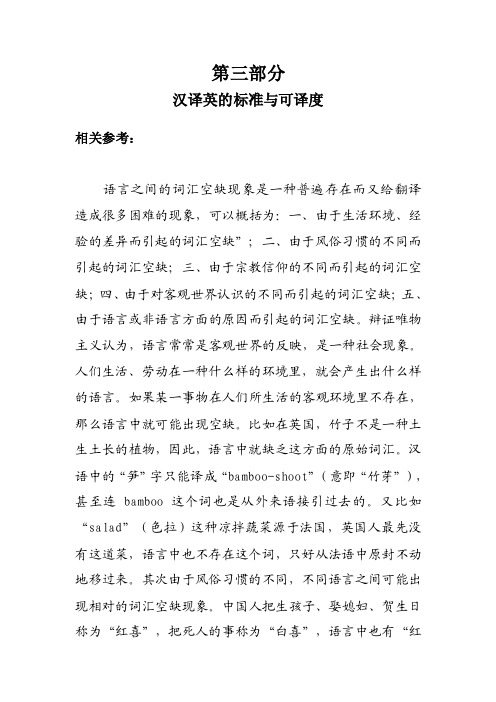
第三部分汉译英的标准与可译度相关参考:语言之间的词汇空缺现象是一种普遍存在而又给翻译造成很多困难的现象,可以概括为:一、由于生活环境、经验的差异而引起的词汇空缺”;二、由于风俗习惯的不同而引起的词汇空缺;三、由于宗教信仰的不同而引起的词汇空缺;四、由于对客观世界认识的不同而引起的词汇空缺;五、由于语言或非语言方面的原因而引起的词汇空缺。
辩证唯物主义认为,语言常常是客观世界的反映,是一种社会现象。
人们生活、劳动在一种什么样的环境里,就会产生出什么样的语言。
如果某一事物在人们所生活的客观环境里不存在,那么语言中就可能出现空缺。
比如在英国,竹子不是一种土生土长的植物,因此,语言中就缺乏这方面的原始词汇。
汉语中的“笋”字只能译成“bamboo-shoot”(意即“竹芽”),甚至连bamboo这个词也是从外来语接引过去的。
又比如“salad”(色拉)这种凉拌蔬菜源于法国,英国人最先没有这道菜,语言中也不存在这个词,只好从法语中原封不动地移过来。
其次由于风俗习惯的不同,不同语言之间可能出现相对的词汇空缺现象。
中国人把生孩子、娶媳妇、贺生日称为“红喜”,把死人的事称为“白喜”,语言中也有“红白喜事”的表示法。
对于没有接触过中国文化或佛教文化的欧美人来说,把死人也当成一大“喜事”,令人大惑不解。
欧美人多信基督教,认为世界是上帝创造的,世上一切也都按上帝的旨意安排。
而在传统中,中国人心目中只有“开天辟地”的盘古和“主宰自然界”的天老爷。
“上帝”(God, Dieu, Gott)和“天老爷”所代表的东西不相同,含义也不一样。
特别是“上帝”这个概念,它具有较浓的基督色彩,是欧美文化的个性,虽然我们可以把英语的“My God!”译成“天哪!”把法语的“Dieu soit loue”译成“谢天谢地”,但反过来把汉语的“天”译成“God”或“Dieu”,有时就不很合适。
翻译古典文献时尤其如此。
再如,汉语和英语中都有“龙”的字眼,但“龙”在英语文化中是没有“地位”的爬行动物,是可怕的恶的象征,在汉语中则恰恰相反。
做翻译的要求范文

做翻译的要求范文
作为一个中文翻译人员,有一些基本的要求需要遵守:
1.准确性:翻译时要确保准确传递原文的意思,避免误导读者或产生歧义。
2.流畅性:翻译应符合中文的表达习惯和语法规范,使读者能够顺畅理解。
3.适应性:要了解读者的背景和文化差异,根据目标读者的需求进行恰当的翻译和调整。
4.专业性:具备翻译相关的专业知识和背景,能够理解并正确转换特定行业或领域的术语。
5.保密性:对原文内容要严守保密,不得泄漏或擅自使用原文信息。
6.响应能力:根据工作的要求,能够及时回复客户的需求和疑问,保持有效的沟通和协作。
7.文化敏感度:了解不同文化之间的差异,避免使用冒犯或不合适的词语或表达方式。
8.更新和学习能力:保持学习的态度,不断更新翻译技能和知识,跟随行业的发展和变化。
请注意,翻译的要求可能因具体情况而有所不同,以上仅为常见的一些要求,具体要求可能会因项目、客户或雇主的要求而有所不同。
英语翻译的原则和技巧

英语翻译的原则和技巧1、增译法:指依据英汉两种语言不同的思维方式、语言习惯和表达方式,在翻译时增添一些词、短句或句子,以便更准确地表达出原文所包涵的意义。
这种方式多半用在汉译英里。
2、省译法:这是与增译法相对应的一种翻译方法,即删去不符合目标语思维习惯、语言习惯和表达方式的词,以避免译文累赘。
增译法的例句反之即可。
例如:(1) You will be staying in this hotel during your visit in Beijing.你在北京访问期间就住在这家饭店里。
(省译物主代词)(2) I hope you will enjoy your stay here.希望您在这儿过得愉快。
(省译物主代词)3、转换法:由于英汉两种语言在语法和表达方式等方面存在着许多差异,因此英译汉时经常有必要改变表达方式,使译文通顺流畅、地道可读。
这种变通技巧就是转换法(shift of perspective)。
4、合并法:由于文化上的差异,英译汉时有时直译原文就会使译入语读者感到费解,甚至误解。
这时,就有必要借用汉语中意义相同或相近、且具有自己鲜亮文化色彩的表达法对原文加以归化。
归化翻译法常用于处理某些英语成语、典故、形象词语等一类文化色彩较浓的表达方式。
恰倒好处地归化可以使译文地道简洁、生动活泼,便于译入语读者理解和接受。
翻译技巧的掌握帮助我们更好融入世界,翻译为我们搭起了各国之间的桥梁,翻译也越来越引起人们的重视。
为了培养更多的翻译人才,中国外文局教育培训中心始终保持专业、革新、开放的理念,精心打造全国复合型国际化人才培养施行基地和全国跨语言跨文化培训服务综合平台,为中国走向世界架桥铺路,为实现"中国梦'努力奉献。
2英语翻译学习技巧注意事项一. 翻译的技巧没有技巧,只有一个熟字。
华罗庚说过,"苦干猛干埋头干,熟能生出百巧来'。
语法根基深厚,词汇量大,对专业词汇掌握得熟,自然就能驾轻就熟,怎么玩儿怎么转。
法汉互译理论与实践 第 (24)

艾,日夜悲号惭愧。(曹雪芹)
Constatant que tous ses semblables é taient jugé s dignes de combler la brè che du firmament, tandis que lui-mê me, en
raison de son incapacité , se voyait é liminé , il (ce Roc) en
la nuit dans la neige, dans la boue, sous la pluie, qui a pris
deux drapeaux, qui a reç u vingt blessures, qui est mort dans l’oubli et dans l’abandon, et qui n’a jamais eu qu’un tort, c’est de trop aimer deux ingrats, son pays et moi. »(Hugo)
法汉互译理论与实践
第24讲 长句处理或句群组织的调整
在翻译过程中,经常会遇到一些长句。长句在法语中尤为常 见,往往呈多层次复合型结构。有些学者把法语和西方语言 的这种结构比喻为“树式机构”。因为法语中有很多形合手 段,所以即使句子很长,但其脉络可以通过形合的标示而显 示出来。汉语的长句则由累积性的多个小句组成,一般呈线 性结构,被喻为“竹式机构”。无论是法语的长句还是汉语 的长句,对译者来说,都需要谨慎处理。翻译的原则是译文 应符合译入语的表达习惯。法译汉时,通常应把法语的“树
第24讲 长句处理或句群组织的调整
分析:本例的汉语句子由累积式小句组成,通过各小句的意 义连接起来。译者将这几个小句处理成多层次的复合句,通 过分词(constatant)和连词(que, tandis que, et)组织句 子,脉络非常清楚,译文突出了法语重形合的特点。
英语翻译标准

英语翻译标准英语翻译作为一项重要的语言交流工具,在国际交流中扮演着举足轻重的角色。
因此,为了确保翻译质量,我们需要遵循一定的翻译标准,以确保翻译的准确性和流畅性。
本文将就英语翻译标准进行探讨,以便更好地指导我们的翻译工作。
首先,准确性是英语翻译的首要标准。
翻译人员需要准确理解原文的含义,并将其准确地表达出来。
这包括对词语、句子甚至段落的准确理解和表达。
在翻译过程中,需要注重原文的语境和语气,尽量做到忠实于原文的意思,避免出现歧义或误导性的翻译。
其次,流畅性也是英语翻译的重要标准。
翻译不仅要准确,还要通顺自然,符合英语的表达习惯和语言特点。
在翻译过程中,需要注重句子的连贯性和语言的流畅性,避免生硬、生涩的表达方式,使译文更具可读性和可理解性。
此外,文化因素也是英语翻译中需要考虑的重要标准。
不同的语言和文化背景会对表达方式和语言习惯产生影响,因此在翻译过程中需要充分考虑原文所处的文化环境,尽量做到不脱离原文的文化内涵,避免产生文化冲突或不当的表达。
另外,专业性和规范性也是英语翻译的标准之一。
翻译人员需要具备扎实的语言功底和丰富的专业知识,尤其是在涉及专业领域的翻译时,需要对相关领域有深入的了解和掌握。
同时,翻译过程中需要遵循一定的规范和规则,比如遵循语法规则、标点符号的使用等,确保译文的准确性和规范性。
总的来说,英语翻译标准涉及到准确性、流畅性、文化因素、专业性和规范性等多个方面。
在翻译工作中,我们需要全面考虑这些标准,确保翻译质量,提高翻译水平,更好地为国际交流服务。
希望本文能够对大家在英语翻译工作中有所帮助,谢谢阅读!。
外语文学翻译如何兼顾忠实性和可读性
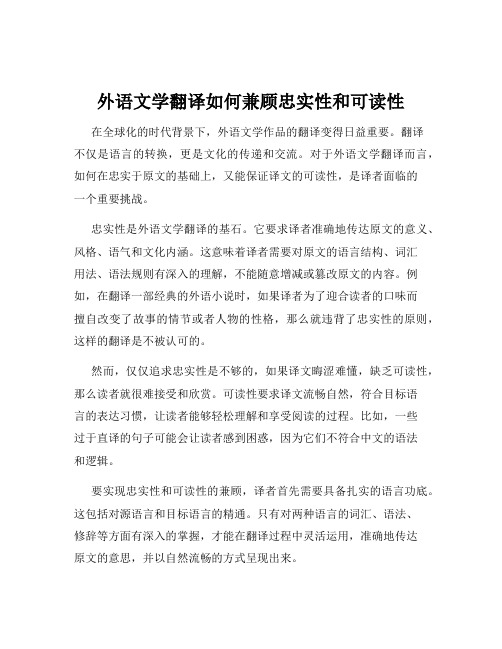
外语文学翻译如何兼顾忠实性和可读性在全球化的时代背景下,外语文学作品的翻译变得日益重要。
翻译不仅是语言的转换,更是文化的传递和交流。
对于外语文学翻译而言,如何在忠实于原文的基础上,又能保证译文的可读性,是译者面临的一个重要挑战。
忠实性是外语文学翻译的基石。
它要求译者准确地传达原文的意义、风格、语气和文化内涵。
这意味着译者需要对原文的语言结构、词汇用法、语法规则有深入的理解,不能随意增减或篡改原文的内容。
例如,在翻译一部经典的外语小说时,如果译者为了迎合读者的口味而擅自改变了故事的情节或者人物的性格,那么就违背了忠实性的原则,这样的翻译是不被认可的。
然而,仅仅追求忠实性是不够的,如果译文晦涩难懂,缺乏可读性,那么读者就很难接受和欣赏。
可读性要求译文流畅自然,符合目标语言的表达习惯,让读者能够轻松理解和享受阅读的过程。
比如,一些过于直译的句子可能会让读者感到困惑,因为它们不符合中文的语法和逻辑。
要实现忠实性和可读性的兼顾,译者首先需要具备扎实的语言功底。
这包括对源语言和目标语言的精通。
只有对两种语言的词汇、语法、修辞等方面有深入的掌握,才能在翻译过程中灵活运用,准确地传达原文的意思,并以自然流畅的方式呈现出来。
同时,译者还需要对源语言所承载的文化有深刻的理解。
外语文学作品往往蕴含着丰富的文化元素,如宗教信仰、风俗习惯、历史背景等。
如果译者对这些文化背景不了解,就很容易在翻译中出现误解或误译。
例如,某些宗教术语或者特定历史时期的词汇,如果译者没有进行深入研究,可能会导致译文的不准确,从而影响读者对作品的理解。
在翻译过程中,灵活运用翻译策略也是至关重要的。
直译和意译是两种常见的翻译方法。
直译可以保留原文的形式和风格,但有时可能会导致译文生硬;意译则更注重传达原文的意思,但可能会在一定程度上牺牲原文的形式。
译者需要根据具体情况,合理选择直译或意译,或者将两者结合起来,以达到最佳的翻译效果。
此外,译者还需要考虑读者的接受能力。
翻译的性质标准及要求

翻译的种类
根据不同的标准,翻译可以分为 多种类型,如语内翻译、语际翻 译、符号翻译等。
翻译的特性
准确性
翻译的首要特性是准确性,译文必须忠实于原文,准确地传达原文的内容和意义。
流畅性
流畅性是翻译的重要特性之一,译文应该通顺、自然,易于理解,符合目标语言的表达 习惯。
文化性
翻译不仅是语言之间的转换,更是文化之间的传递。译文应该尽可能保留原文的文化特 色和内涵,以实现跨文化的交流和理解。
语言习惯的转换
总结词
保持译文语言的自然流畅
详细描述
在翻译过程中,译者需要关注原文和译文的语言习惯,以确保译文语言的自然流畅。这包括对原文的 句式、语气、修辞等方面的处理,以及在译文中运用符合目标语言习惯的表达方式。
专业术语的运用
总结词
准确翻译专业术语
VS
详细描述
在翻译涉及特定领域的文本时,专业术语 的准确翻译至关重要。为了确保译文的准 确性,译者需要具备相关领域的知识储备 ,并能够根据上下文选择合适的术语进行 翻译。同时,对于不确定的术语,译者需 要进行查证和核实,以确保译文的准确性 。
翻译的种类
口译
口译是指通过口头表达将一种语 言的信息用另一种语言表达出来,
通常用于会议、谈判、演讲等场 合。
笔译
笔译是指通过书面文字将一种语言 的信息用另一种语言表达出来,如 文学翻译、科技翻译、商务翻译等。
同声传译
同声传译是指在讲话人讲话的同时, 将讲话内容用另一种语言表达出来, 通常用于国际会议、商务谈判等场 合。
翻译的速度与效率
翻译速度的要求
在保证翻译质量和准确性的前提 下,需要尽可能提高翻译的速度 ,以满足客户的需求。
翻译效率的提高
当责所属保任翻译
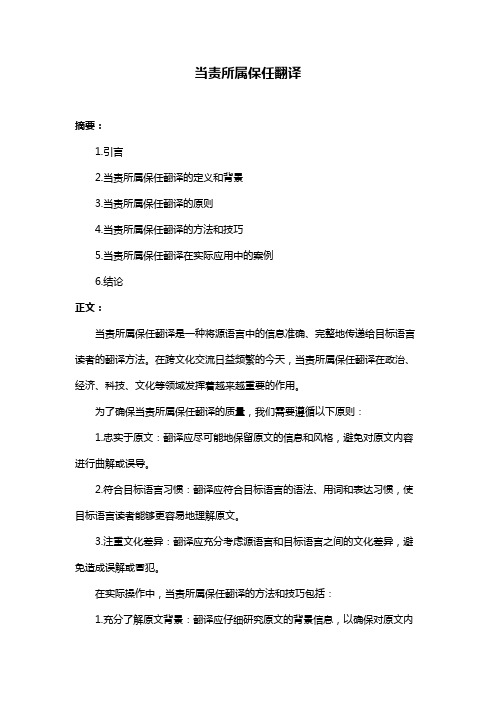
当责所属保任翻译
摘要:
1.引言
2.当责所属保任翻译的定义和背景
3.当责所属保任翻译的原则
4.当责所属保任翻译的方法和技巧
5.当责所属保任翻译在实际应用中的案例
6.结论
正文:
当责所属保任翻译是一种将源语言中的信息准确、完整地传递给目标语言读者的翻译方法。
在跨文化交流日益频繁的今天,当责所属保任翻译在政治、经济、科技、文化等领域发挥着越来越重要的作用。
为了确保当责所属保任翻译的质量,我们需要遵循以下原则:
1.忠实于原文:翻译应尽可能地保留原文的信息和风格,避免对原文内容进行曲解或误导。
2.符合目标语言习惯:翻译应符合目标语言的语法、用词和表达习惯,使目标语言读者能够更容易地理解原文。
3.注重文化差异:翻译应充分考虑源语言和目标语言之间的文化差异,避免造成误解或冒犯。
在实际操作中,当责所属保任翻译的方法和技巧包括:
1.充分了解原文背景:翻译应仔细研究原文的背景信息,以确保对原文内
容有全面、准确的理解。
2.精确翻译关键词:翻译应重点关注原文中的关键词和专业术语,保证其在目标语言中具有相同的含义。
3.保持语言简洁明了:翻译应尽量使用简洁、明了的语言表达,使目标语言读者更容易理解。
4.反复修改完善:翻译应通过反复修改和完善,确保译文质量达到要求。
当责所属保任翻译在实际应用中具有很高的价值。
例如,在商务谈判中,准确的翻译可以帮助双方更好地沟通,避免因语言障碍而导致的误解;在法律领域,精确的翻译有助于确保合同、法规等文件的准确执行;在科技领域,当责所属保任翻译可以为国际技术合作提供保障。
总之,当责所属保任翻译在当今世界的跨文化交流中具有重要意义。
- 1、下载文档前请自行甄别文档内容的完整性,平台不提供额外的编辑、内容补充、找答案等附加服务。
- 2、"仅部分预览"的文档,不可在线预览部分如存在完整性等问题,可反馈申请退款(可完整预览的文档不适用该条件!)。
- 3、如文档侵犯您的权益,请联系客服反馈,我们会尽快为您处理(人工客服工作时间:9:00-18:30)。
谈翻译应符合外语的表达习惯
发表时间:2011-07-28T17:37:49.653Z 来源:《魅力中国》2011年6月上供稿作者:赵甲平[导读] 从属于语言学层面的字面移译逐步转向文化层面的阐释和再现。
赵甲平(防空兵指挥学院河南郑州 450000)
中图分类号:H315.9 文献标识码:A 文章编号:1673-0992(2011)06-0000-01 摘要:外语翻译并非词与词、句与句的简单对等翻译,而是反映理解和接受意义的思维过程。
外语和汉语族的思维习惯不同, 因此表达习惯也就有所不同。
有些句子翻译后可能完全符合语法形式,但若仔细体会,却可反映的思维方式和表达习惯不同。
关键词:翻译;表达;习惯
翻译现在正经历一种转折: 从属于语言学层面的字面移译逐步转向文化层面的阐释和再现。
英汉翻译如此, 汉英翻译也是一样。
它并非词与词、句与句的简单对等翻译,而是反映理解和接受意义的思维过程。
一个种族的表达习惯是长期思维习惯的结果。
汉英语族的思维习惯不同,因此表达习惯也不同,这是造成中国式英语的重要原因。
在翻译过程中不能只拘泥于句子的语法形式而忽略表达习惯。
因为有些句子翻译成英语后可能完全符合语法形式, 但若仔细体会,却可反映汉英思维方式和表达习惯的不同。
一、汉语先叙述某件事情,再表达自己的感觉。
而英语通常先说出感觉再叙事。
1、答不出这个问题,我觉得很难堪。
汉语表达习惯(以下简称汉) :Because I couldn’t answer this question , I felt ashamed.
英语表达习惯(以下简称英) : I felt ashamed of not being able to answer the question.
2、玛丽没有被邀请,所以很失望。
汉: Because she was not invited, Mary was disappointed. 英: Mary was disappointed that she was not invited.
3、他这样对待我, 我很生气。
汉: The way he treated me made me angry.
英: I was angry at the way he treated me.
二、和对于英语语族的人来说, 汉语语族人喜欢用动词表达自己,而英语族人注重抽象思维, 常化动为静名词化是英语语言的一个重要特征。
1、因为有桩生意要做,所以我进城了。
汉:Because I had some business, I went to town.
英:Business took me to town.
2、我们经常在家和地铁站之间来往。
汉: We usually walk to or from subway.
英: Our usual walk was to or from the subway.
3、参观了位于茂物的国家博物馆和植物园后, 我们就结束了这次的旅程。
汉: After we visited the National Museum and the Botanical Gardens at Bogor, we completed our tour. 英:The National Museum and the Botanical Gardens at Bogor completed our visit.
三、汉语中经常会看到无主句, 而英语强调以主体为中心。
因此, 翻译时应添加必要的主体词
1、没有良好的习惯, 就不能在英语上取得很大的进步。
Without good habit, you can’t make a great progress in English.
2、当时几乎不可能回到那家旅馆。
It was impossible to return to that hotel at that time
四、汉语中经常主客体交融, 而英语中事物所属关系清晰
1、这两幢楼的外表很相似。
汉: These two buildings appearances are similar.
英: These two buildings are similar in appearance to each other.
2、孩子们的岁数从5 岁到7 岁不等。
汉:The children’s age ranges from 5 to 7.
英:The children’s range in age is from 5 to 7.
五、汉语句式描述在前总结在后,而翻译成英语后变成总结在前, 描述在后
1、居然还有学生在考试之前踢足球, 这似乎令人难以置信。
汉:There were some students still playing football before exam. This seemed incredible. 英: It seemed incredible that some students still played football before exam.
2、拳击尚未开始, 对手就故意认输了, 这还是第一次。
汉:Before the bout began the fighter was to take a dive. This was the first time. 英: It was the first time the fighter was taken a dive even before the bout began.
六、汉语的句式中,指代词通常指代前面所提到的名词, 而英语句式则不然
1、当约翰18 岁的时候, 他的第一本书就发表了。
汉:When John was 18, he had his first book published.
英:When he was 18, John had his first book published.
2、在约翰写的《健康》一书中, 他指出健康是一个人将来成功的基础。
汉: On John’s book《On Health》, he points out that health is the foundation of one’s future success.
英:On his book《On Health》,John points out that health is the foundation of one’s future success.
种种迹象表面说明,只是追求表面形式的对应而忽略英文表达习惯,学生的思维是不可能跳出底层次的语言形式层面而进入高级的语义和逻辑层面。
因此,在教学过程中有必要让学生充分意识到追求表面形式的局限性。
参考文献:
[1]《英汉大辞典》主编陆谷孙,第2版,上海译文出版社;
[2]《多功能分类词典》上海外语教育出版社;
[3]《英语语法大全》外文出版社;
[4]《汉英词典》商务出版社。
